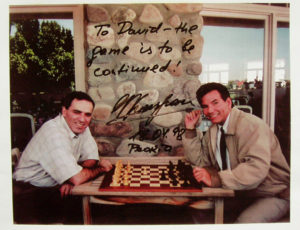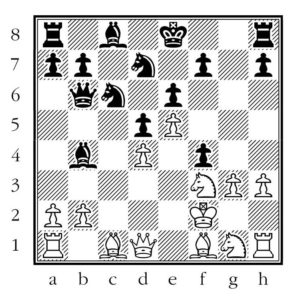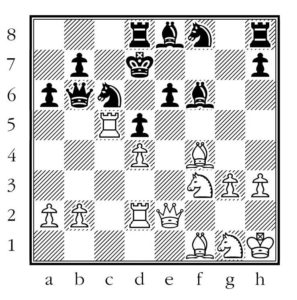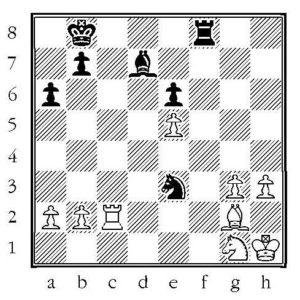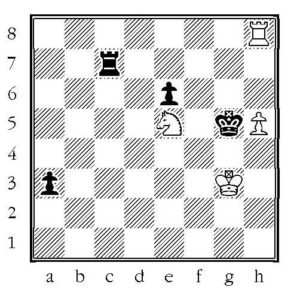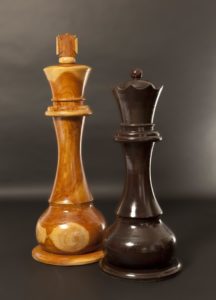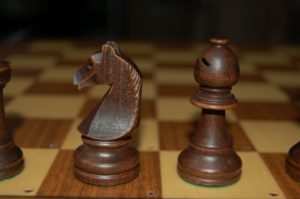|
(Colorado Chess Informant – January 1996) By NM Todd Bardwick This game holds the Colorado record for the longest game between masters and is unofficially the longest continuous game (without an adjournment) between masters in United States. Our journey begins at 5:00 p.m. on Sunday, September 3, 1995 (Round 4, Colorado Open). Little did David or I know that we would fight past midnight and well into the morning. I finally achieved a draw on move 143 by claiming a 50 move draw at 5:00 a.m. on September 6 (only 12 hours later!), the only 50 move draw in my chess career. Although the endgame with R+N vs. R is a theoretical draw (in most cases!), David had no losing chances and opted to play to the wee hours of the morning. Since the Colorado Closed in 1995, David had been playing excellent chess as he had 28 wins and only one draw (to Michael Mulyar) in his last 29 Colorado games, prior to this tournament. In mid August, he had placed second in the U. S. Open where he had a performance rating of around 2600! Fortunately for me, the tournament time control was not sudden death (where I would have been hard pressed to defend such a position under a time constraint). We played into the 7th time control – 20 moves in an hour, repeating. David was familiar with a well-publicized game earlier in the year where GM Walter Browne won a R+N vs. R endgame against SM Thomas Wolski in a sudden death situation. The ending is difficult for the weak side, but drawable. David chose to test my endgame play and endurance. The beneficiaries of this game were our 5th round (Mulyar and McCarty) and 6th round opponents. David later told me that he played his last round games like a blitz game, where he made moves that made sense, but was too tired to analyze them and hoped for the best! I had similar experiences on Monday. I got two hours of sleep this night, after being awake for 23 straight hours. It is real difficult to play against top-level competition when you feel like someone just hit you over the head with a 2×4! In my last round game, Chris Brunt was kind enough to wake me up during our game when it was my move just before time pressure! In the Guinness Book of Records, world record for the longest master game ever went 269 moves and took 20 hours and 15 minutes! It was a draw between Ivan Nikolic and Goran Arsovic in Belgrade, Yugoslavia, on February 17, 1989. Also, special thanks should go to tournament director, Ron MacRall, who stayed up all night with us and didn’t complain too much. Afterwards, Ron announced that he would only direct sudden death tournaments in the future! And lastly, I would like to dedicate this game to Colorado expert, Martin T. “Tuna” Deschner who is an advocate of this variation of the French Defense in the Tarrasch Variation. White: SM David Gliksman (Lucky) Black: NM Todd Bardwick French Defense, Tuna Variation 1.e4 e6 2.d4 d5 3.Nd2 Nf6 4.e5 Nfd7 5.f4 (this move categorizes the “Tuna Variation”) c5 6.c3 Nc6 7.Ndf3 Qb6 8.g3 cd4 9.cd4 Bb4+ 10.Kf2 g5!? (This move first made it’s appearance in a game between Yudasin and Kaplun in 1984. The normal line, 10…f6, has fallen out of favor as white gains an advantage in all lines. I recently talked to IM John Watson who is writing a new book on the French Defense which should be available sometime in early 1996. John said that this line has become popular at the GM level and he has devoted appropriate space for it in his book. John also told me that, in his estimation, about half of the top 50 players in the world now use the French Defense as their favorite weapon against 1.e4. Of course, therefore, modern theory on the French is expanding rapidly today.) 11.h3 (To prevent 11…g4. Black equalizes after 11.fg5 Nde5 12.Ne5 Ne5 13.Be3 Nc4! Yudasin-Kaplun, USSR 1994, continued 11.Bh3?! h5! 12.Ng5 Qd4+ 13.Qd4 Nd4 14.Ne2 Nc2=/+) 11…gf4
12.Bf4 (12.gf4 is answered by 12…f6. Then 13.Be3 Be7 14.Qd2 Nf8 15.Bd3 Bd7 16.Ne2 0-0-0 with an even game.) 12…f6 13.Kg2 Be7 (This is the start of what turns out to be an inaccurate move order. If black is going to castle queenside, he should play 13…fe5. Play could follow 14.Ne5 Nde5 15.de5 Bd7 16.a3 Be7 17.b4 0-0-0; Rossmann-Knaak, East Germany 1984. Black can also play 13…Bf8 14.Rh2 Bg7 15.Kh1 0-0=) 14.Rh2 Nf8 15.Kh1 Bd7 (15…Ng6 is probably best. I was mentally obsessed with castling queenside and underestimated the strength of white’s dark square bishop, which keeps the black king from reaching a8. Black is a tempo slow in getting in Ng6 in a couple moves to free his game.) 16.ef6 Bf6 17.Rd2 O-O-O? (Black should play 17…Ng6 and castle kingside. His king is now stuck in the center of the battle.) 18.Rc1 Be8 (18…Ng6 19.Bd6 Be7 20.Be7 Nge7 allows …Kb8, but also gives up more control of e5.) 19.Rc5 a6 (White threatens 20.Rb5) 20.Qe2 Kd7? (20…Be7 followed by …Bd6 is much better, but black really can’t afford to give up more tempi as white can complete his development and go to work on black’s weaknesses. I suspected at the time that centralizing my king in the middlegame against the runner-up in the ‘95 U.S. Open was suicide! Where is the brilliancy to finish black off?)
21.Ne5+ Be5 22.Be5 Ne5 23.Qe5 Ng6 24.Qg7+ Kd6 25.Bg2 Rd7? (25…Bc6 followed by …Rd7 is a better try in a bad position.) 26.Qf6 (This is the position I missed when I played 20…Kd7. I was hoping to trade pieces or gain the initiative by chasing the white queen away with my rook. The Rd5+ threat is lethal and cannot be defended.) 26…Rf8 27.Rd5+ Kc7 28.Rd7+ Bd7 29.Rc2+ Kb8 30.Qg7 (Unfortunately, the h-pawn falls too.) 30…Qd6 31.Qh7 Ne7 32.Qe4 Nd5 (32…Nc6 33.d5 ed5 34.Qd5 and black must trade queens or retreat. I was hoping to eventually win the d4 pawn. Trading the center pawns only makes white’s endgame easier.) 33.Qe5 Qe5 34.de5 Ne3 (Black can only harass white for a little while.)
35.Rd2 Bb5 (35…Ng2 36.Rd7 Rf2 37.Nf3 Rb2 38.Rd2 only simplifies the position for white.) 36.g4 Kc7 37.b3 a5 (37…Bf1 38.Bf1 Nf1 39.Rg2 Kc6 or 37…Ng2 38.Kg2 Bc6+ 39.Kh2 Rf1 are also possible, but black is losing in all lines.) 38.a4 Ng2 39.ab4 Ne3 40.Rd3 Nd5 (end of first time control: 5:55, 5:57) 41.Rf3 Rb8 (41…Rc8 or 41…Rd8 is stronger) 42.Rf7+ Kb6 43.Nf3 Rc8 (43…Kb5 44.Nd4+ Kb4 45.Kg2 Kc3 46.Ne6 Re8 47.Rf3+ Kb4 48.Rd3 Nc3 is a better try.) 44.g5 Rh8 45.h4 Ne3 46.Kh2 Nf5 47.Kh3 Kb5 48.Rb7+? (Surprisingly, this may allow black to draw! Black’s king position will be improved quickly as he races toward the e5 pawn on the way to white’s g and h pawns. David suggested later that 48.g6! is winning for white as he rushes to advance his passed pawns before black’s king can come to the rescue.) 48…Kc6 49.Rf7 (49.Ra7 Rb8 50.Ra5 Rb3 51.Kg2 is possibly stronger for white.) 49…Kd5 50.g6 (50.Kg4 Ke4 51.Rd7 or 50.Rc7 Ke4 51.Kg4 are also ideas for white in this complex ending.) 50…Ke4 51.Rh7 Rg8 52.Ng5+ Ke5 (Better is 52…Kf4 53.Ne6+ Ke5 54.Ng5 Rg6 with a probable draw.) 53.h5 Rb8 54.Nf3+ Kf4 55.Nd2 Rd8 (55…e5 56.Kg2 a4 57.g7 Rg8 58.ba4 Ng7 59.Kf1 Nf5 60.Nc4 Rc8 is also interesting, and complicated) 56.Nc4 Rd3+ 57.Kh2 Rb3 (Black has managed to capture white’s last queenside pawn, taking with it most of white’s winning chances. Now with the superior king position, all black has to do is stop the g & h pawn in order to draw.) 58.Rf7 (58.Na5 Rc3 59.g7 Rg3 is also drawn for black.) 58…Kg5 59.g7 Nh6 60.Rf8 a4 (end of second time control: 6:56, 6:59) 61.Rh8 Rb7 62.Rh6 Rg7 63.Rh8 Rc7 64.Ne5 a3 65.Kg3
65…a2?! (65…Ra7 is a much easier draw which could have given us both a lot more sleep this night as the knight must be sacrificed for the a-pawn. I debated for a while about which move to play and picked the wrong one…it’s getting late!) 66.Nf3+ Kf6 67.Ra8 Rc5 68.h6 (It is now midnight and the other long game, Zupa vs. Morrow is now over. Daoud and Hans had an exciting 2 rook and pawn endgame with pawns close to queening. We are sad to see them go home as now there is nothing left in the room to watch for entertainment. The tournament site is real quiet and the second part of our story – A Long Knight’s Journey into Day – has just begun!) 68…Kg6 69.Ra2 Kh6 (This starts the first 50 move draw count for black) 70.Kf4 Rf5+ 71.Kg4 Kg7 72.Re2 Kf6 73.Nd4 Re5 74.Rf2+ Kg6 75.Nf3 Re4+ 76.Kg3 Ra4 77.Ne5+ Kg5 78.Rf8 Rb4 79.Kf3 Ra4 80.Ke3 Rb4 (end of third time control: 7:20, 7:58) 81.Nf3+Kg6 82.Nd4 Rb1 83.Kf4 Rf1+ 84.Nf3 Kg7 85.Ra8 Kf6 86.Ra6 Rb1 87.Nd2 Rb7 88.Ne4+ Ke7 89.Nc5 Rb1 90.Ke5 Re1+ 91.Ne4 Kd7 92.Rd6+ Ke7 93.Re6+ (There is no way for black to save the pawn. David did not want to capture the pawn right away as it poses no real threat to him and it’s presence makes black’s position more complicated to defend. This move starts a new 50 move draw count. ) 93…Kd7 94.Rh6 Kc7 95.Kd5 Rd1+ 96.Kc4 Kd7 97.Rg6 Ke7 98.Ra6 Kf7 99.Nc3 Rd2 100.Nd5 Rd1 (end of fouth time control: 7:37, 8:32) 101.Rd6 Kg7 102.Kc5 Rd2 103.Re6 Kf7 104.Kd6 Rd1 105.Re2 Kg6 106.Ke6 Rg1 107.Nf4+ Kg7 108.Ke7 Rg4 109.Re4 Rg1 110.Re6 Rg5 111.Rf6 Ra5 112.Rg6+ Kh7 113.Rg4 Ra7+ 114.Kf6 Ra6+ 115.Ne6 Rb6 (The strategy for black is keep the knight pinned to the king where it can’t help to form a mating net. If the white king breaks the pin, black will try to perpetual check with the rook. Black must also try to keep his rook and king far apart so that they don’t get forked by the knight.)
116.Rh4+ Kg8 117.Ra4 Kh7 118.Ra8 Rd6 119.Ra1 Rb6 (Fortunately for black, he always has one square to escape to in order to avoid mate. B+R vs. R gives the strong side better winning chances since the bishop can cover enemy king escape squares that the knight can’t cover.) 120.Ra2 Rd6 (end of fifth time control: 8:51, 9:43) 121.Rh2+ Kg8 122.Rh6 Ra6 123.Kf5 Ra5+ 124.Kg6 Ra6 125.Kh5 Ra1 126.Rf6 Rh1+ 127.Kg6 Rg1+ 128.Ng5 Rg2 (A similar position as occurred on move 115. This position is rotated 90 degrees with the knight pinned one file from the edge of the board instead of 2 files.)129.Re6 Kf8 130.Re1 Rg4 131.Re3 Rg1 132.Kf6 Rf1+ 133.Nf3 Ra1 134.Nd4 Rf1+ 135.Nf5 Rf2 (We have seen this position’s cousin before!) 136.Ra3 Ke8 137.Rd3 Rf1 138.Rd2 Rf4 139.Ke5 Rf1 140.Nd6+ Ke7 (end of sixth time control: 9:33, 10:23) 141.Ra2 Re1+ 142.Ne4 Kf7 143.Ra7+ Kg6 Draw!
|
